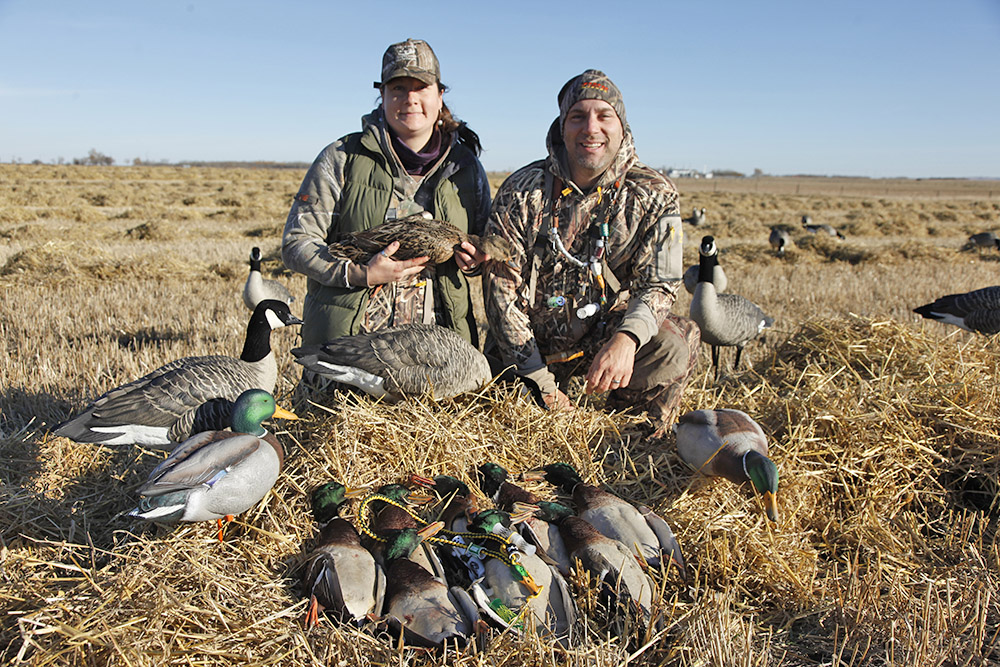Dry Ducks
Many waterfowl enthusiasts only hunt ducks over water and don’t feel their experience is the same without a set up on the wetlands to foster and sustain their love for ducks and geese. In the Pacific and Central Flyways, hunting the agricultural fields the birds use to feed in, is a unique experience that can generate incredible sights and sounds without having to wiggle into waders.
Spotting
Any avid duck hunter notices when birds are in the sky. I’m always on the lookout for birds and pay attention to what I see throughout the fall. The key to setting up a successful field shoot is to find concentrations of birds staging along their migration route.
Maps are a great tool for locating large staging wetlands that will draw and hold large numbers of birds. Being familiar with my hunting area, I already know the best wetlands to watch and focus my spotting efforts. Google Earth is a great tool, allowing you to find productive wetlands with suitable habitat to hold birds.
Spotting an area consists of travelling to the wetlands that hold birds and following them out to where they are feeding. It can often mean chasing the birds for miles, but if you lose one flock, there will be others to follow. Watching the direction of flight of the first flocks leaving will provide your starting point. Fields used for feeding will have birds circling and landing for several hours in the morning and evening. Getting permission to hunt is a critical link to success.
The field
Paying attention to what the birds are doing in the field will ensure you are in the right spot when you set up. Ducks have an incredible sense for finding the best areas of a field where there is grain spillage and other great feeding opportunities. You want to pinpoint the exact location where birds are feeding, as they will return to that spot the next time they come out to feed. Being a couple of hundred metres off the spot, often means birds won’t decoy without some coaxing, so set up where the birds want to feed, to ensure they center your decoy spread and finish close enough to see every detail in their feathers.
There are key crops in different regions that ducks have developed an appetite for, and they continue to change as producers find new and profitable grains and seeds to grow. Barley has been a long-time favourite, but field peas are attracting lots of hungry ducks. If you aren’t sure what the ducks are eating, take the time to dissect the crops of harvested birds to figure out their favorites.
Watch for content birds
Ducks are cautious creatures and they like the security of open spaces. The best shoots will have birds landing in the middle of big fields. If birds are pushing fence lines or roads, there is a good chance that they are bouncing around trying to find the best feeding locations. Watching bouncing birds until they settle down into a prime feeding location will always provide the best shooting opportunities—being patient is worth the time investment.
Decoys
Often hundreds, if not thousands of ducks, will concentrate in good feeding fields. The longer they feed in one location, the larger their numbers can grow. To make your decoy spread look realistic, and provide birds with confidence to come in, you have to have enough bodies on the ground.
I start with six to eight dozen decoys and haven’t found there is such a thing as too many. Safety in numbers is a confidence builder for birds returning to a field and if you have a good spread of decoys, the birds often wing straight in to join the party.
Ducks will decoy well into Canada goose decoys so don’t worry if you don’t have a good spread of duck decoys, just use the honker spread.
If there are hundreds of birds in arriving flights, you must give them enough room to land as a flock, or they will bounce to find a spot to land without running into each other. When birds are flaring, you have set the landing area too tight.
Calls
Excited birds, wanting to feed, make a considerable amount of noise. To make your decoy spread convincible, you must have calls to make it realistic. Try to imagine how strange it would be for a duck to come to a field, where their buddies are usually chuckling and quacking, only to be greeted with silence? I’m sure alarm bells go off in their tiny brains at something that seems completely unbelievable.
Blinds
You can spend a considerable amount of time spotting and setting up, and if you aren’t well hidden, all your efforts will be in vain. Even if ducks are used to coming to a field, foreign objects or the faces or outlines of hunters will send them elsewhere.
Layout blinds have become the norm for hunting fields and covering the hides with natural vegetation and straw from the field will help you to blend in even further. In areas where birds are hunted heavily, ducks often get wise to layouts, so changing your approach may be the ticket to success. Bale or willow blinds were extremely popular in years past and if you switch back to a historical blind if birds are wary, it can make all the difference in the world. Stay flexible and let the birds dictate what makes them comfortable.







